The word asbestos can be extremely worrying when heard, especially when it relates to your home. It can conjur up all manner of horrible visions and thoughts about financial outlay and, most importantly, potential risks to your families health!
In this guide we take a detailed look at all aspects of asbestos such as where it’s commonly found, how to test for it and what to do if you find any. Read on to find out all you need to know.
Understanding Asbestos
Asbestos comprises naturally occurring minerals with microscopic, fibrous structures, in times past, prized for their strength, pliability, and fire resistance.
It belongs to two mineral families: Serpentine, with curly fibres, and Amphibole, featuring sharp, needle-like fibres linked to greater cancer and other serious conditions risk at lower doses.
Aside form teh 2 family-types, it’s also present in six different forms — Chrysotile, Amosite, Tremolite, Crocidolite, Anthophyllite, and Actinolite – each has unique properties suited to specific applications.
Initially hailed for its insulative properties, asbestos was later recognised as a carcinogen, posing life threatening health risks when fibres are inhaled, particularly during DIY projects or home renovations.
Asbestos fibres can lodge in lung tissue, creating inflammation and causing health issues that may only manifest years later, as the body struggles to break down these durable fibres.
In its solid state, asbestos is harmless; however, when disturbed and released into the air as powdery these fibres, known as friable asbestos, it becomes extremely dangerous and poses significant health hazards.
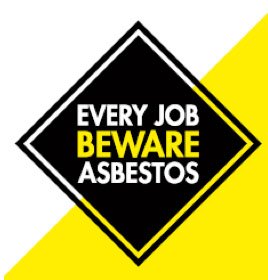
The HSE gives health warnings on asbestos location and removal
Types of Asbestos
Asbestos exists in six forms that are primarily extracted through mining:
- Chrysotile Asbestos – Known as white asbestos and is the most common form found in buildings, it’s extensively used in construction for fireproofing, insulation, and automotive brake linings.
- Amosite Asbestos – Also known as brown asbestos, it’s the second most commonly found substance and is used in acoustic materials, insulation, and anti-condensation products, commonly found in pipework insulation and cement boards.
- Tremolite Asbestos – Found in various colours, white, brown, grey, green and even transparent, typically not used commercially but may be present as contaminated deposits in talc or vermiculite.
- Crocidolite Asbestos – Referred to as Blue Asbestos (due to its colour), utilised in plastic reinforcement, rope lagging, pipe insulation, and older spray-on coatings.
- Anthophyllite Asbestos – Found in white, grey, or dull green varieties, used in cement products and insulation, often as a contaminant in Chrysotile. Generally very rare.
- Actinolite Asbestos – Rare and typically found in white, grey, or dull green forms, seldom used in products, usually present only as a contaminant.
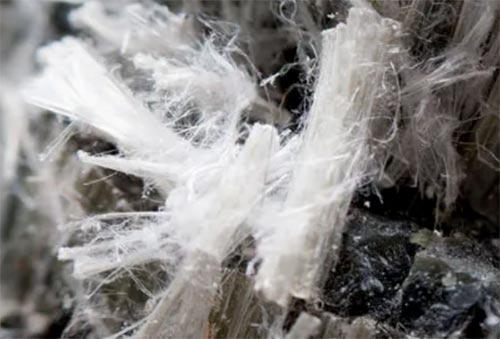
chrysotile asbestos fibres
Understanding the Risks of Asbestos
Asbestos presents a significant health hazard due to its tiny, inhalable fibres that lodge in the lungs, leading to long-term health issues.
Its durability means the body struggles to break it down, causing scarring and inflammation that can result in numerous serious conditions like mesothelioma, asbestosis and also cancer.
Widespread use throughout the 1960’s and 70’s means many UK homes contain traces of asbestos, often in materials homeowners may not recognise, posing significant risks during and form of DIY and home improvement projects.
While solid forms like sheets or tiles are safe when left alone, asbestos becomes dangerous when broken as it releases tiny airborne fibres that can then be easily breathed in by anyone in the vicinity.
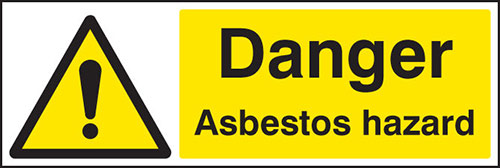
Asbestos hazard warning sign
Where Asbestos Lurks
Asbestos hides in numerous products, common in both commercial and residential settings, making its presence widespread.
Primarily utilised for rigidity, insulation, soundproofing, and fire resistance, asbestos can be found in various places.
Some common locations are generally in older structures such as barns, sheds and outhouses, in roof and floor tiles, flue pipes, gutters, foul water drainage, insulation and pipe lagging.
It’s also possible to find it in textured coatings such as artex applied to walls and ceilings before 1980, however it’s a real possibility it can be present in any home but before the year 2000, when legislation was introduced.
To summarise, it’s generally found in the following products:
- Cladding
- Guttering and downpipes
- Roofing sheets
- Adhesive
- Brake pads
- Cement
- Plasterboard
- Vinyl/lino tiles
- Soil and vent pipes
- Pipe lagging and insulation
- Gaskets
- Older battery casings (usually lead acid)
- Rubber
- Talc
- Vermiculite

Asbestos cladding, guttering and downpipes on an old building
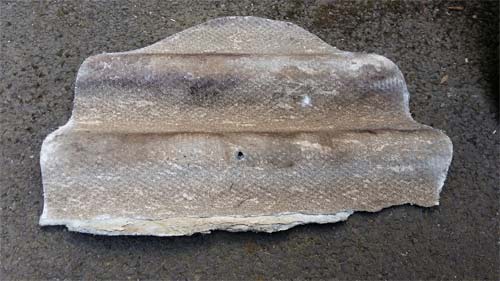
Corrugated roofing sheets may be made of asbestos
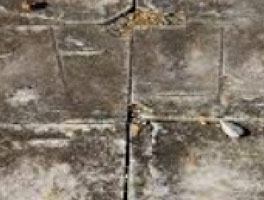
Older floor tiles may contain asbestos
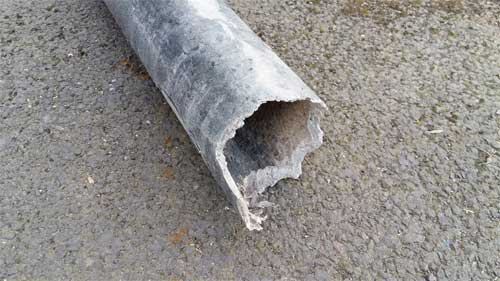
Toilet soil and vent pipe made of asbestos
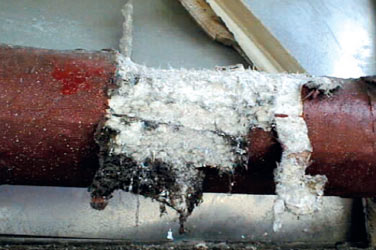
Older pipe lagging can contain asbestos
Is Asbestos Still Used in the UK?
In short, no, asbestos is no longer used for any products that can be bought or sold in the UK. Due to the risks that it posed to health, in 1985 the use of both brown and blue types of asbestos was banned by the HSE (Health and Safety Executive) and to complete the commonly used set, the use of white asbestos was banned in 1999, again by the HSE.
This being said, although it was banned from use in any products made after these dates, it was not made law to have every trace of it removed from the many homes, commercial properties and machines it was used in, so the likelihood that it still exists in many of these areas is great and should always be considered when any work is undertaken.
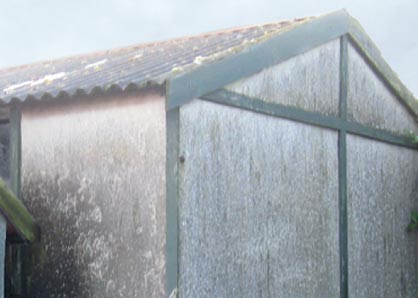
Outhouses and garages may contain asbestos
How Do I Encounter Asbestos?
At home, exposure to asbestos typically occurs during renovation or construction work, especially when surfaces containing asbestos are sanded or structures are fractured or broken.
If you suspect asbestos in your home, it’s essential to have it tested before undertaking any work on or near it.
Today, asbestos testing is a very quick, simple and accessible process. Many companies offer convenient postal testing services, with results usually available within a week, for as little as £50.
While undisturbed asbestos poses minimal to no risk, any disturbance can significantly increase the danger, so awareness of its presence is crucial.
With this in mind, if you are in any doubt at all as to whether an object you intend on working on or near contains asbestos, get it tested!
Asbestos Testing Made Easy
Nowadays, testing suspected asbestos-containing materials is a straightforward process. You can use a mail order DIY asbestos testing kit, from one of the many companies available online, found via a simple Google search.
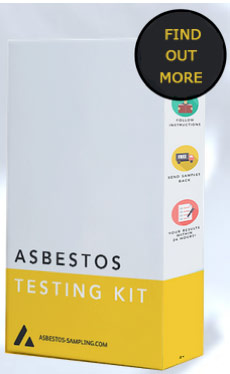
Simply place a small sample of the material in a prepaid envelope and send it to the lab. Results are typically available within 24 hours.
Once received, you take a tiny sample from several locations of etc suspect material, pop them into the sample bags provided in the kit and then send it back to the lab. Results are usually available in 24 hours.
More Substantial Suspicious Materials
For larger, more substantial asbestos issues, you will need to arrange an asbestos inspection, you can contact your local authority. Use this link to find the appropriate local authority to you .
Your local council will connect you with an external contractor for assessment. Any removal and disposal costs are your responsibility. Visit the Asbestos Removal Contractors Association Website for further details.
Dealing with Asbestos Discovery
If you suspect asbestos, stay calm. The danger arises when it’s damaged or disturbed, so as long as it remains in one piece and untouched, it should be fine. Refer to the summary below for proper procedure.
For assistance in Ireland, visit citizensinformation.ie.
For Wales, see wales.nhs.uk, and for Scotland, check out scotland.shelter.org.uk.
Above all else, just don’t touch or disturb it!
Asbestos Removal
Removing asbestos involves navigating through various regulations based on three key factors:
- Type of asbestos
- Amount of asbestos
- Licensing requirements for removal
Given the complexity arising from different asbestos types and quantities, it’s safest to avoid removal without proper knowledge and licensing.
However, for confirmed asbestos-containing artex, DIY removal using products like Eco Solutions X-Tex Artex Remover is an option.
This gel-like substance encapsulates asbestos fibres during removal, preventing airborne release. Ensure proper safety gear like goggles, gloves, and an FFP3 mask is used at all times, just to cover all bases.
Attempting removal without appropriate precautions can lead to serious health risks. Asbestos-related diseases claim more lives annually than road accidents, according to the Health and Safety Executive, so take precautions at all levels, even though it may be safe.

Artex could contain asbestos
Understanding Asbestos Regulations
Asbestos regulations have evolved significantly since its dangers were first identified after a tragic incident involving an employee in an asbestos textiles factory.
It took nearly a century for governments to establish comprehensive legislation outlining asbestos types, risks, and permissible uses.
The latest regulations, implemented in 2012 following a European directive, emphasise safety measures. For purely domestic situations, the rules are:
- Leave asbestos materials in your home undisturbed if they’re in good condition, but monitor their status and avoid disturbing them without expert guidance.
- Before undertaking any work in areas possibly containing asbestos, you must manage the asbestos responsibly to ensure safety for yourself and others present.
- Additional rules concerning asbestos awareness and safety that you also need to be aware of are outlined in The Control of Asbestos Regulations 2012.
Summary: What to Do If You Suspect Asbestos
- Do not disturb the surface under any circumstances
- Review this free handout, detailing the governments asbestos reference cards
- Order an asbestos sample testing kit from one of the many companies available online or consult the Governments Asbestos in the home data-base to find out where to get help. It’s important to mention here that the government/local council method usually takes a minimum of 10 days, however identifying asbestos with an asbestos sampling kit can take as little as 24 hours
- Check out the 2 following handouts (linked below) and the one linked to above to see whether you need a license to remove the particular type of asbestos you have found. If it is, go to the Asbestos Removal Contractors Association to find a local contractor for removal. Our handouts are available here:
- No license is needed under the Occupational Health and Safety Regulations 2007 if the asbestos area is under 10 square meters and not friable. Removal must also be performed in less than 1 hour in any period of 7 days.
- If no licence needed, follow the rules stated in the handouts to the letter as to what personal protective equipment (PPE) needs to be used during removal and also on how it is then disposed of after completion.
A big thanks to the HSE (Health and Safety Executive) for information and images that went into completing this advice.
If you suspect asbestos in your home or need to test materials, read through this project and accompanying handouts thoroughly. Always prioritize your safety and use appropriate safety gear.

